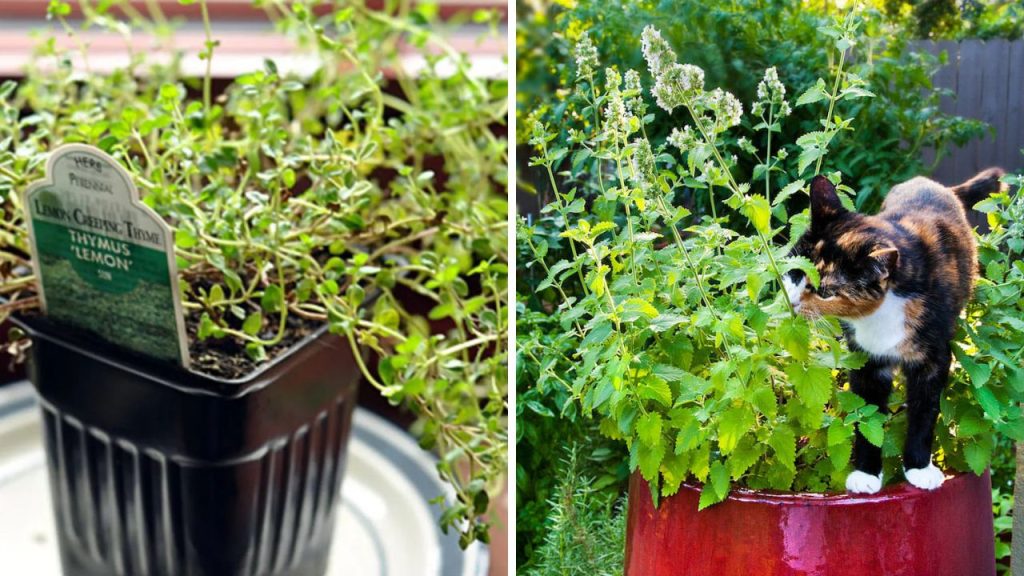If you love the charm of the mountains and want to bring that vibe to your own backyard, check out these 19 alpine garden ideas. From rocky arrangements to colorful mountain flowers, there’s something here that’ll inspire your next gardening project and turn your outdoor space into a little slice of alpine paradise.
Incorporating Alpine Herbs for Culinary Use
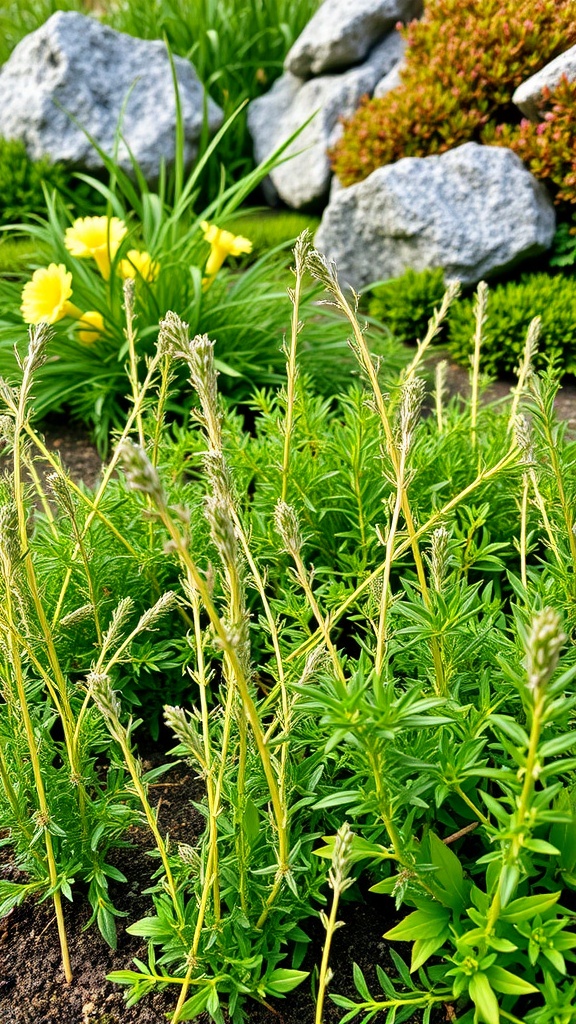
Alpine gardens are not just about beautiful flowers and rocks; they can also be a great source of fresh herbs. The image shows a vibrant array of alpine herbs, thriving in a well-designed garden. These herbs are perfect for adding unique flavors to your meals.
Some popular alpine herbs to consider include thyme, oregano, and chives. They grow well in rocky soil and require minimal care. Imagine stepping outside to snip fresh herbs for your pasta or salad! It’s a delightful way to enhance your cooking.
To incorporate these herbs into your culinary repertoire, start by planting a mix of your favorites. Ensure they have good drainage and plenty of sunlight. When it’s time to harvest, simply cut the leaves or stems as needed. You can dry the herbs for future use or use them fresh to bring out their vibrant flavors in your dishes.
Integrating Native Flora for Authenticity
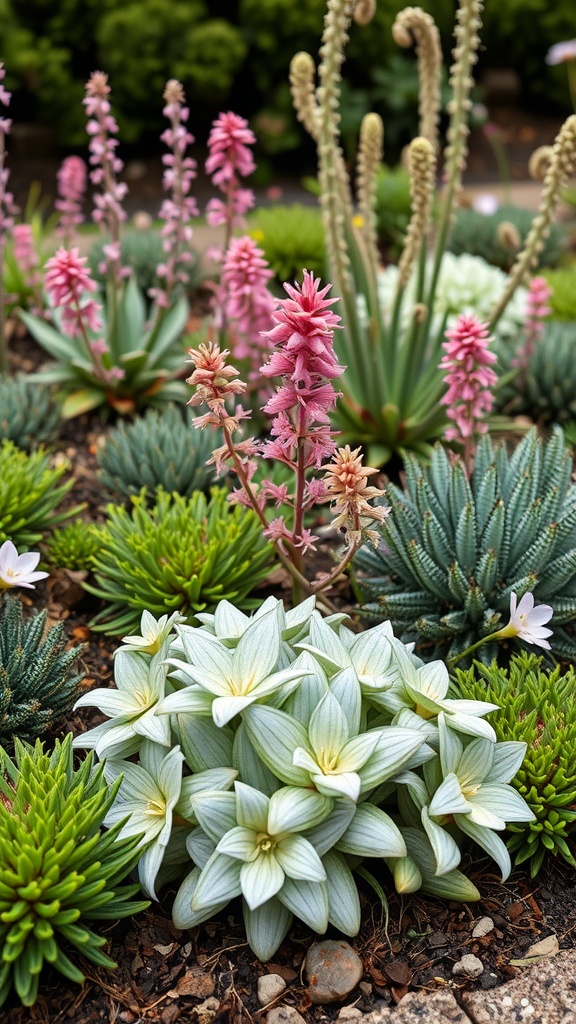
Creating an alpine garden is all about capturing the essence of nature. The image showcases stunning native plants that thrive in mountainous regions, bringing authenticity to the landscape. These lush greens and vibrant pinks not only beautify the space but also echo the natural habitat.
Incorporating native flora like those seen here can provide harmony and balance in your garden design. The unique shapes and colors of these plants offer visual interest while supporting local ecosystems. Whether you choose succulents or flowering varieties, each plant contributes to a sense of place.
It’s important to choose plants that are well-adapted to your climate. This ensures they flourish with minimal care, allowing you to enjoy the garden without constant attention. Plus, native plants typically require less water and are resilient to local pests.
Mixing different textures and colors, as shown in the image, creates a lively garden. By integrating native flora, you’ll cultivate an authentic alpine garden that celebrates the beauty of the natural world.
Creating a Stone-Crafted Alpine Oasis
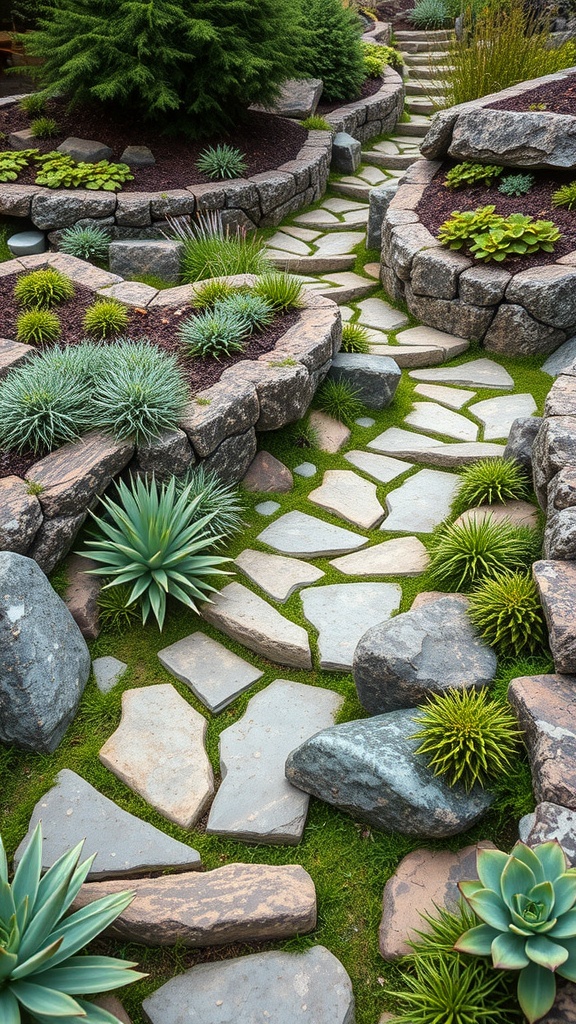
Imagine walking through a serene garden that feels like a slice of nature right at your doorstep. This stone-crafted alpine oasis does just that. The winding stone pathway invites you to explore while surrounding plants add texture and color.
The stones, carefully laid out, create a rustic charm. They blend seamlessly with the lush greenery, making every step an experience. The vibrant succulents and fine grasses bring life to the design, showcasing how stone and plant life can harmonize.
This design is not just visually appealing; it’s also practical. The stones help with drainage and provide a sturdy path through your garden. With a bit of planning, you can create your own version of this beautiful alpine retreat.
Elevated Planting Beds for Better Drainage
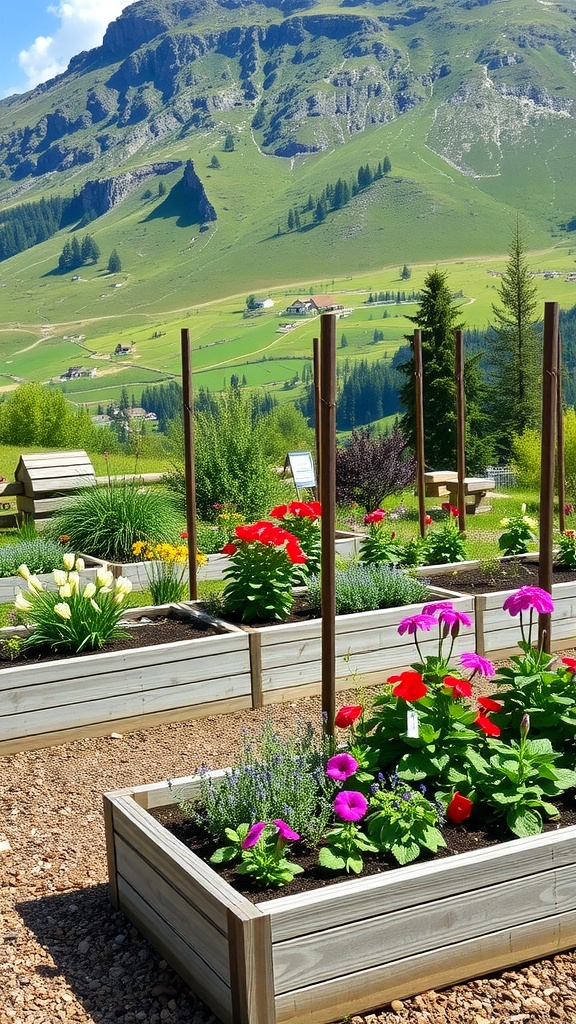
Elevated planting beds are a smart choice if you’re looking to improve drainage for your alpine garden. These raised beds allow water to flow away from the roots, preventing soggy soil that can harm plants.
The image showcases neatly arranged wooden beds filled with colorful flowers, set against a stunning mountain backdrop. The vibrant blooms like petunias and geraniums stand out against the lush greenery of the hills. This setup not only looks beautiful but also functions well for growing a variety of plants.
Using elevated beds also means easier access for planting and maintenance. You won’t need to bend down as much, making gardening a little less strenuous. Plus, they tend to warm up faster in the spring, giving your plants a head start.
Overall, elevated planting beds not only enhance the aesthetic appeal of your garden but also improve plant health by ensuring effective drainage. If you want a garden that thrives, this is definitely a method to consider!
Tranquil Water Features for Alpine Serenity
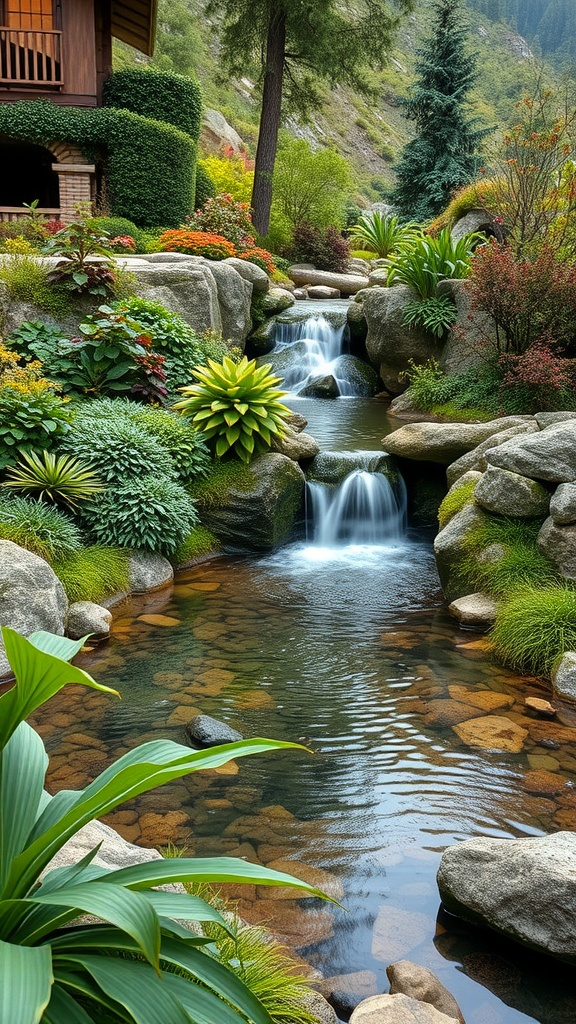
Water features can transform any garden into a peaceful retreat. In an alpine garden, a serene stream or gentle waterfall creates a soothing atmosphere. The image captures the essence of tranquility with flowing water, surrounded by lush greenery and smooth stones.
The gentle sound of water can help to mask background noise, allowing you to relax and enjoy nature. Positioning rocks and plants around the water can enhance the natural look, making it blend seamlessly into the landscape. Consider using local stones to connect the feature to the alpine environment.
Incorporating aquatic plants can add beauty and functionality. Plants like water lilies or rushes can flourish in the shallow areas of a pond or stream. These plants not only provide visual interest but also support local wildlife.
The color palette in this image showcases rich greens and earthy tones. This creates a calming scene where one can unwind after a long day. Whether it’s a small fountain or a larger waterfall, water features invite serenity into your alpine garden.
Rocky Terraces for Varied Plant Heights
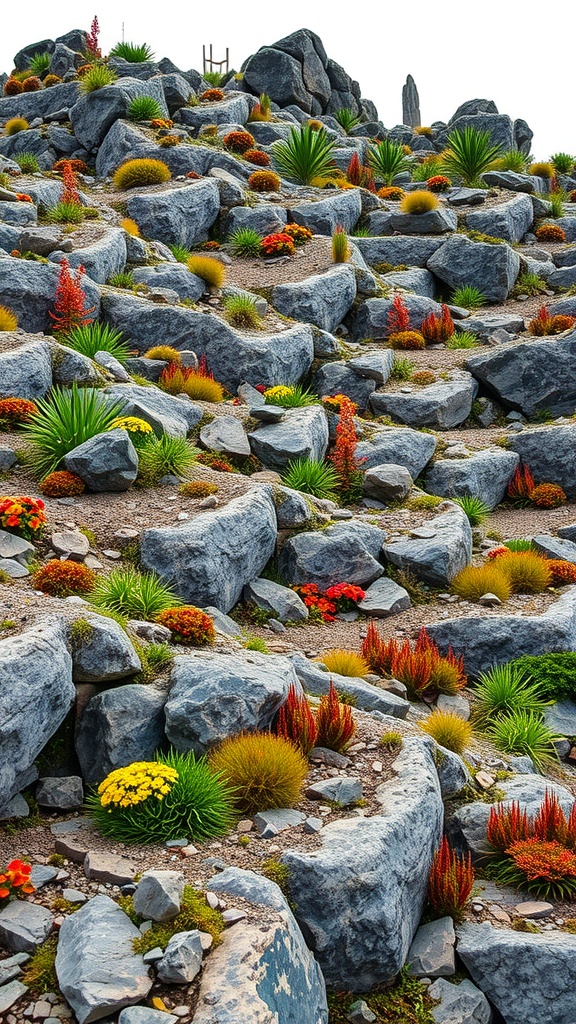
Rocky terraces create a stunning visual effect in alpine gardens. The layers of stones allow for different plant heights, making the garden lively and dynamic. Plants thrive in the crevices, drawing attention to their colors and textures.
This image showcases a beautiful example of such a design. The large, rugged rocks form a natural backdrop that highlights the vibrant flowers and lush greenery. The contrast between the hard stones and soft plants is quite appealing.
Creating your own rocky terrace can be quite simple. Start with a variety of stones in different sizes. Arrange them in a way that creates levels, allowing sunlight to reach various plant types. Choose plants that fit well in rocky environments, such as succulents, alpine flowers, and hardy grasses.
The layout encourages a sense of growth and movement, making your garden a captivating place to relax and enjoy. Plus, with the right selection of plants, you can ensure that your garden remains colorful through the seasons.
Vibrant Succulents in Rocky Outcrops
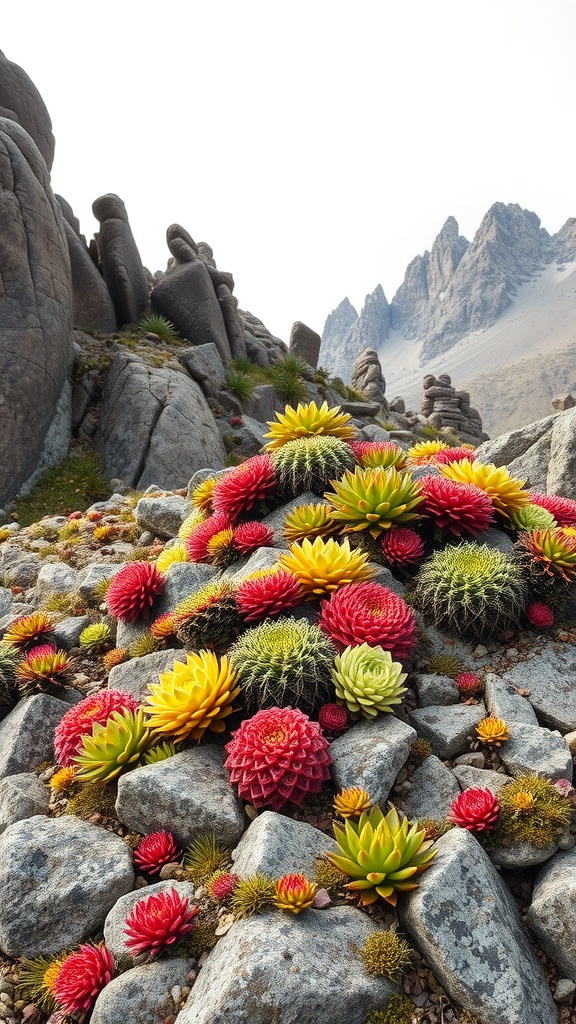
Picture a stunning scene where bright succulents thrive amidst rugged rocky terrain. This unique combination showcases how nature can bring life and color to harsh environments. The vibrant hues of reds, yellows, and greens create a lively contrast with the stoic gray rocks.
Succulents are perfect for these rocky outcrops. Their ability to store water allows them to flourish where other plants might struggle. This resilient nature makes them a fantastic choice for anyone looking to add some character to their garden.
Consider arranging these colorful succulents in clusters to mimic the natural layout seen in the image. Grouping them not only enhances their visual appeal but also creates a dynamic display that draws the eye. You can use rocks to further define the space, creating a natural look that feels both intentional and wild.
With a little creativity, you can transform your garden into a unique alpine oasis. Planting succulents in rocky settings is not just practical, it’s also a fun way to express your personal style. Let your imagination run wild and enjoy the splashes of color that succulents can bring to your outdoor space.
Decorative Gravel Paths Enhancing Garden Design
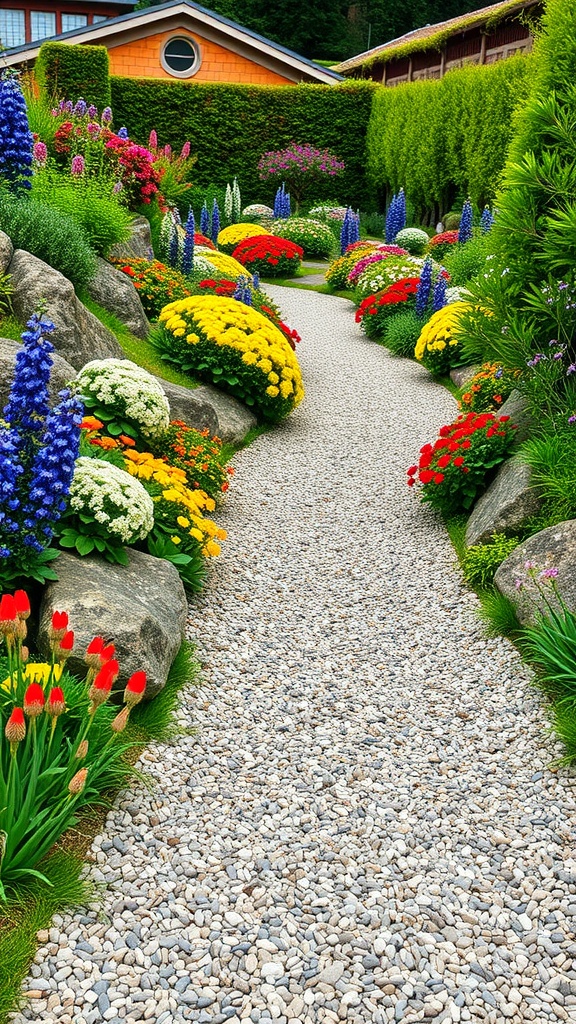
Gravel paths are a charming feature in any garden, especially in alpine designs. The image showcases a beautiful gravel path winding through lush flowers and greenery. This layout not only guides visitors through the garden but also highlights the vibrant colors of the plants.
The use of decorative gravel gives a relaxed, natural feel. It complements the colorful blooms, such as red tulips, yellow chrysanthemums, and blue delphiniums. These flowers create a stunning contrast against the path and surrounding rocks.
Gravel paths are practical too. They provide easy access while allowing for good drainage. This makes them suitable for various weather conditions. The texture of the gravel adds an extra layer of interest, inviting guests to stroll and enjoy the scenery.
Adding features like rocks and bordered flower beds enhances the path’s appeal. This design draws the eye and creates a sense of flow. Overall, a gravel path can transform a garden into a welcoming retreat.
Using Miniature Statues for Visual Interest
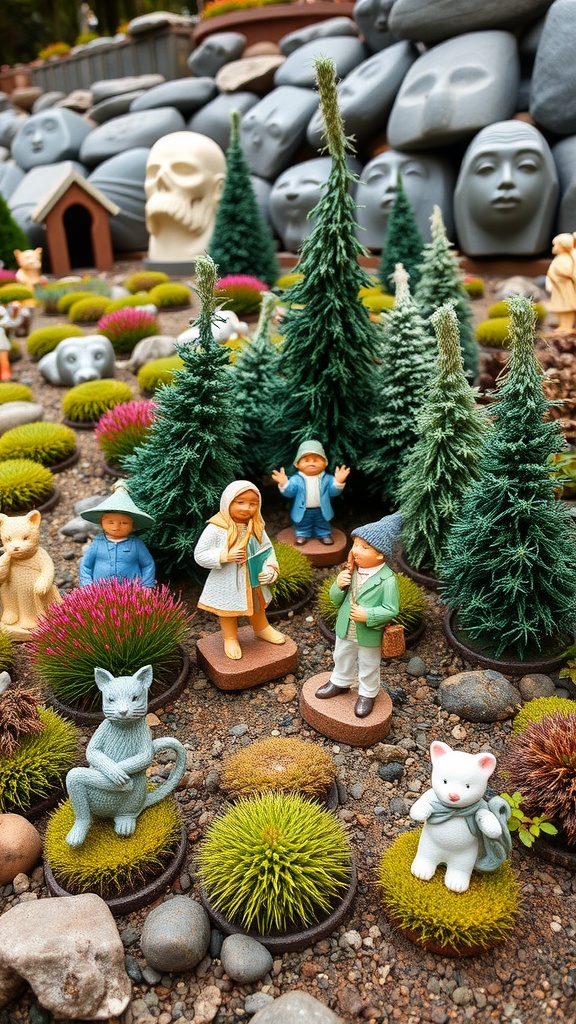
Miniature statues can bring a playful twist to your alpine garden. The image showcases a lively scene with small figures surrounded by vibrant greenery and interesting textures. These charming figures add character and invite curiosity.
In the picture, you can see little people engaging in various activities, like exploring and enjoying nature. Cute animal figurines sit among the plants, creating a whimsical atmosphere. This blend of elements makes the garden feel alive.
Using these statues not only enhances the garden’s beauty but also serves as a conversation starter. Guests might want to know the story behind each figure. It’s a simple way to create a narrative in your outdoor space.
Positioning these statues among plants like mosses and small trees creates a delightful contrast. The colors and shapes draw the eye, making the garden feel more dynamic. Whether you prefer a playful vibe or something more serene, miniature statues can help you achieve that look.
Vertical Gardens for Space-Saving Solutions

Vertical gardens are a fantastic way to maximize space while adding beauty to your outdoor area. This image showcases a vibrant wall filled with various flowers and greenery, creating a stunning vertical display.
The arrangement features colorful blooms like pink roses and purple spikes, which draw the eye and bring life to the wall. The lush greenery not only adds texture but also helps purify the air around the garden.
Creating a vertical garden can be a fun DIY project. You can use wall-mounted planters or repurpose materials like pallets for a unique look. Think about the types of plants that thrive in your climate and choose a mix of flowers and foliage for visual interest.
Vertical gardens are perfect for small spaces, patios, or balconies. They allow you to enjoy gardening even if you have limited ground space. Plus, they can act as a natural privacy screen, making your outdoor area feel more secluded.
Colorful Flower Clusters Against a Backdrop
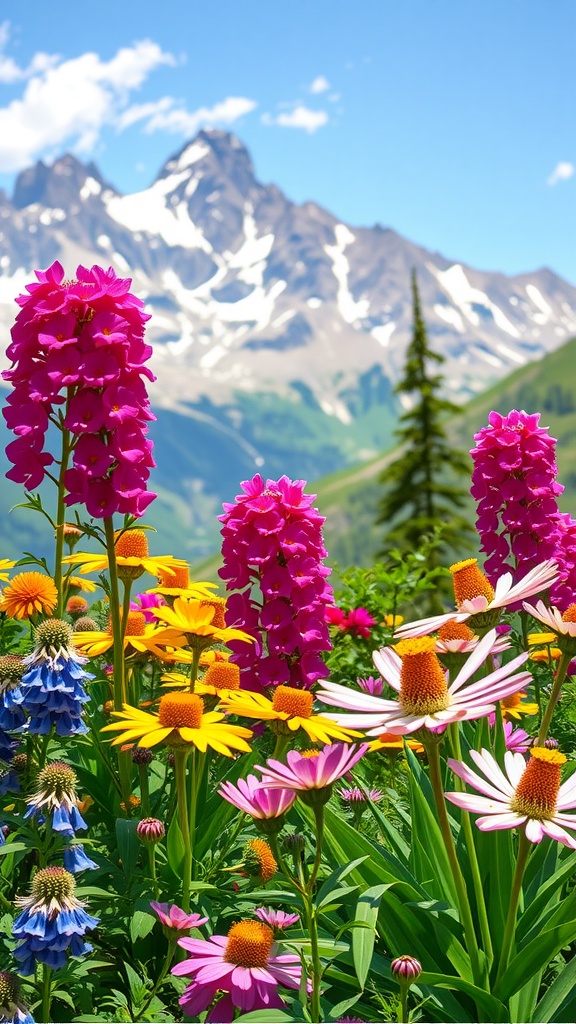
Picture a stunning view where vibrant flower clusters create a lively contrast against majestic mountains. This alpine garden is a feast for the eyes, bringing together a variety of colors and shapes that dance in the sunlight. You can spot bright pinks, sunny yellows, and deep blues among the greenery, making it hard to look away.
The flowers in this garden serve as a wonderful reminder of nature’s beauty. They not only attract attention but also provide a habitat for butterflies and bees. Each flower contributes to a sense of harmony, creating a peaceful spot that feels both inviting and refreshing.
What’s more, having colorful flowers in your alpine garden can boost your mood. They add a cheerful vibe to any space, turning a simple garden into a lively retreat. Whether you’re relaxing with a book or hosting friends, these blooms will surely enchant everyone who visits.
Seasonal Plant Selection for Year-Round Interest
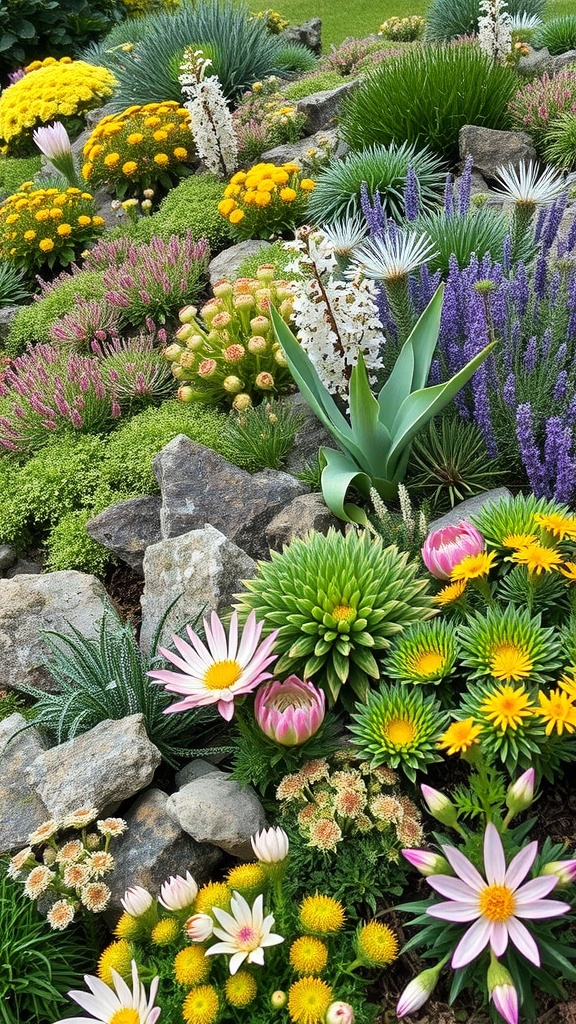
Creating an alpine garden can be a rewarding experience, and the right plant selection adds year-round charm. The image showcases a vibrant mix of plants set against natural stone, illustrating how diverse alpine flora can thrive together.
In the foreground, you see colorful daisies and striking succulents that provide a cheerful pop of color during the warmer months. They are complemented by hardy perennials like lavender and heather, which bloom beautifully in spring and summer.
As seasons change, consider incorporating plants that offer interest in fall and winter. Evergreens and ornamental grasses add texture and structure when many flowers have faded. This mix ensures your garden remains visually appealing all year long.
To maintain a dynamic garden, choose plants that bloom at different times. This approach keeps the garden lively, with new colors and textures emerging throughout the seasons. By layering plants carefully, you can create a lush environment that invites exploration and enjoyment.
Creating Cozy Seating Areas Amongst Nature
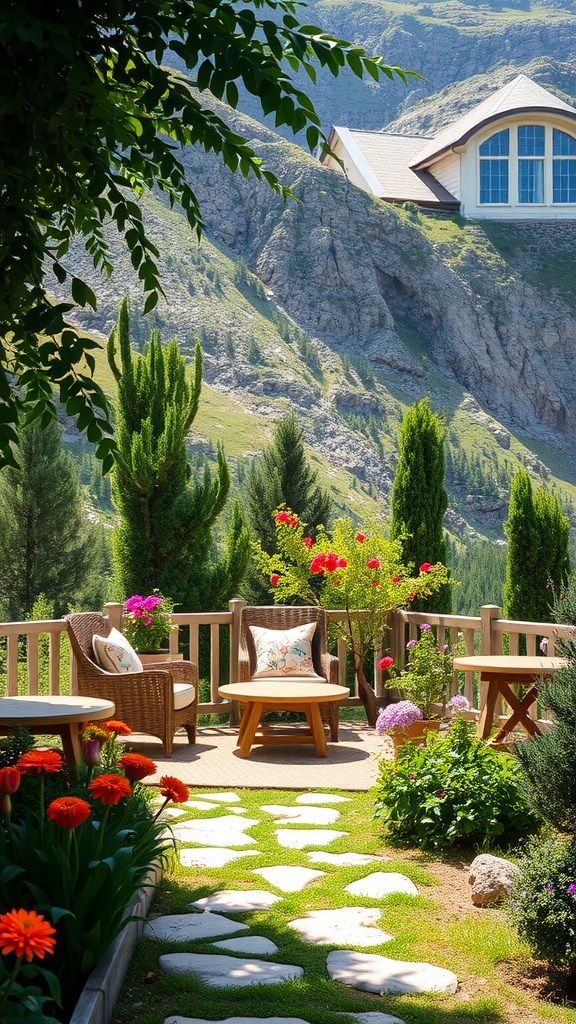
Imagine stepping out into a serene garden that invites you to sit back and relax. This beautiful setup features comfortable seating surrounded by vibrant flowers and lush greenery. The blend of nature and cozy furniture creates a perfect spot for unwinding.
The stone path leading to the seating area adds charm and guides guests through the garden. Bright orange and pink flowers stretch across the space, providing pops of color that cheer up the setting. A few tables are ready for drinks or snacks, making it a great space for socializing or enjoying quiet moments.
The backdrop of majestic mountains enhances the beauty of this outdoor area, making it feel like a hidden gem. This kind of cozy seating arrangement is ideal for enjoying warm sunny days or cool evenings, allowing nature’s beauty to be part of your relaxation.
Using Boulders as Natural Sculptures
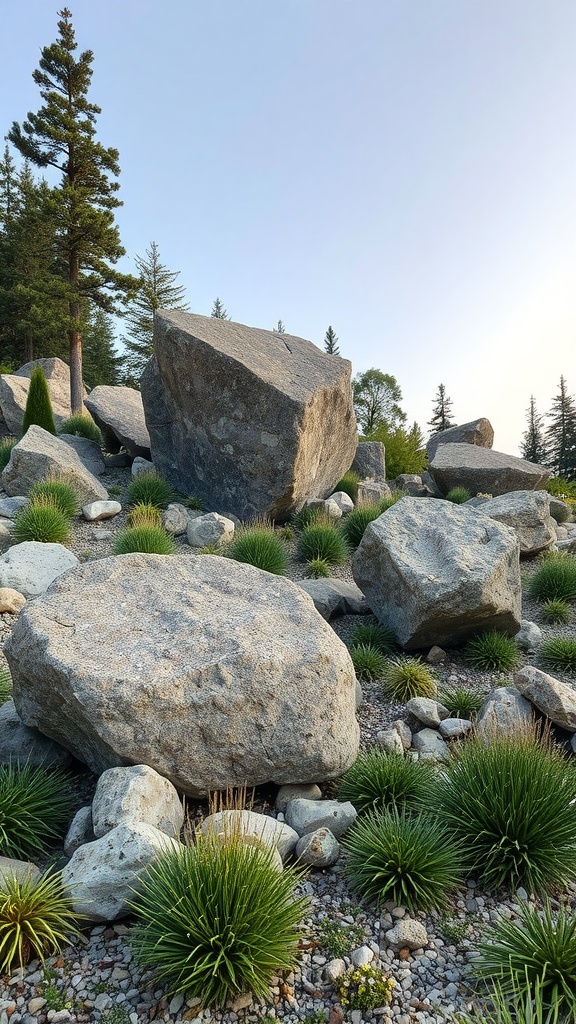
Boulders can bring a unique touch to any alpine garden. The image showcases a stunning arrangement of large rocks, which effortlessly blend into the surrounding greenery. These natural sculptures add texture and depth to the landscape, making it visually appealing.
Incorporating boulders in your garden design helps create an organic look. They can act as focal points or guide the eye across the space. The arrangement of rocks seen in the photo inspires creativity, showing how varying sizes and shapes can harmonize with plants and pathways.
The native grasses in the image complement the boulders beautifully. Their soft textures contrast with the rugged surfaces of the stones, fostering a sense of balance. When selecting plants, consider those that thrive in similar conditions to the rocks, which can enhance the overall aesthetic.
Creating Pathways with Recycled Materials
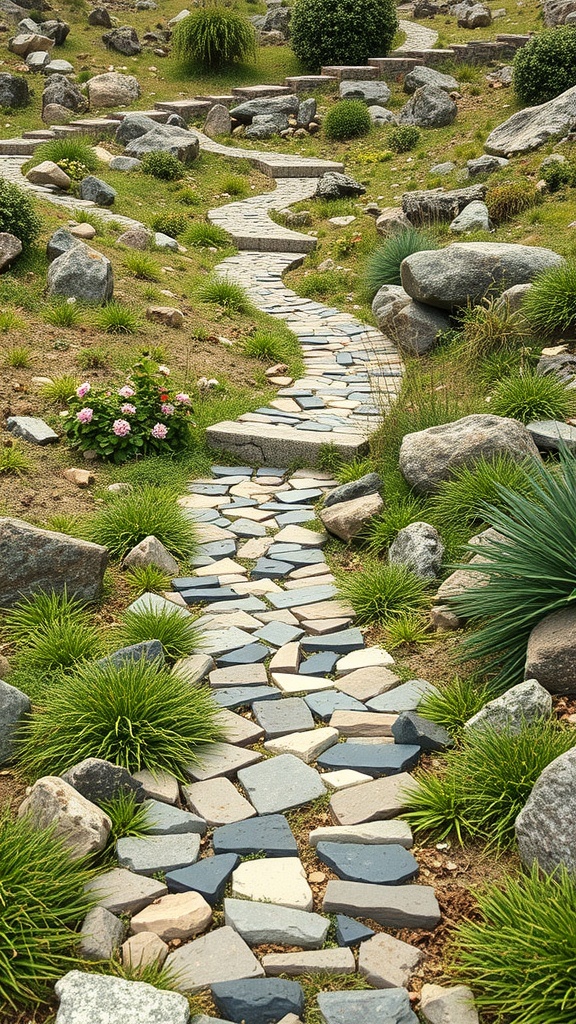
Pathways in an alpine garden add charm and function. Using recycled materials not only saves money but also helps the environment. Imagine a winding path made of leftover stones or bricks, creating a unique look that blends with nature.
The image shows a beautifully constructed pathway, crafted from various stone pieces. The colors and shapes of the stones create a mosaic effect, making the walkway visually appealing. This design draws the eye and encourages visitors to explore the garden.
Surrounding the path, lush green plants and rocks complement the stones. This natural setting enhances the garden’s beauty and promotes biodiversity. Adding flowers along the edges brings color and attracts pollinators.
Creating a path with recycled materials is a rewarding project. You’ll enjoy the satisfaction of using what you have on hand. Plus, it’s a great way to showcase your creativity. Each stone tells a story, and together, they create a welcoming space for relaxation and enjoyment.
